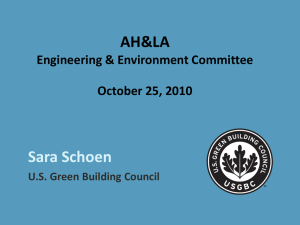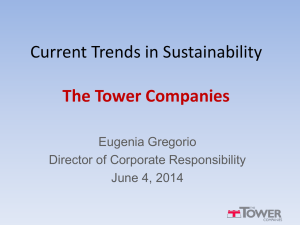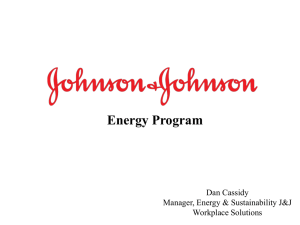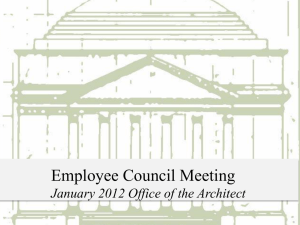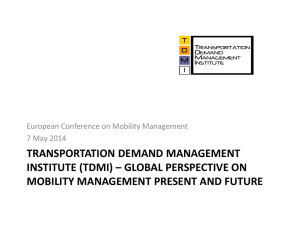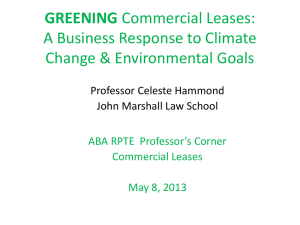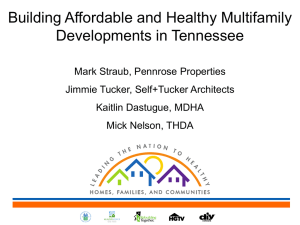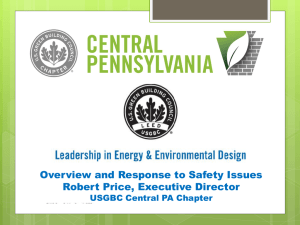GREEN TOOLKIT CONTRACTORS CORE RESPONSIBILITIES
advertisement
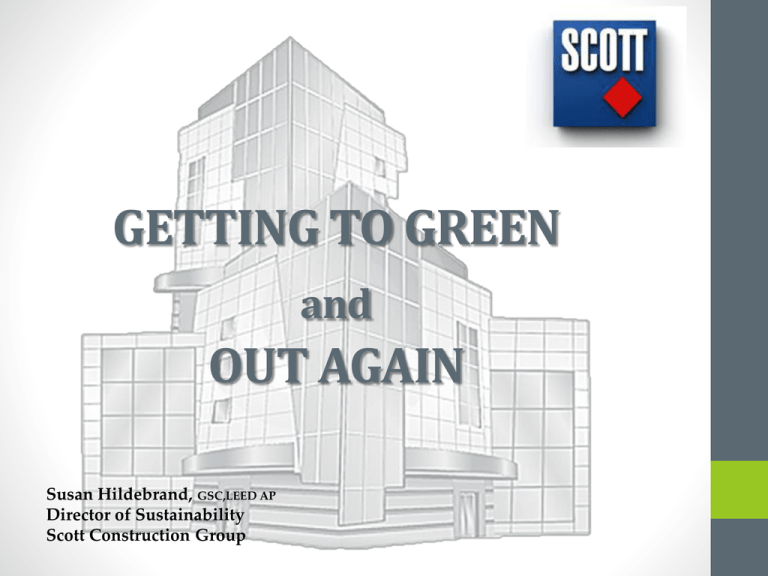
GETTING TO GREEN and OUT AGAIN Susan Hildebrand, GSC,LEED AP Director of Sustainability Scott Construction Group TOPICS FOR DISCUSSION LEED Credits and Contractor Responsibility Defining the role of the Contractor Implementing LEED requirements on the construction site Challenges, obstacles, issues for contractors Cost of implementation WHY GREEN BUILDING RATING SYSTEMS ? To define “green” and “sustainable” buildings by providing a rating system by which the design for energy and environmental criteria can be measured. Establish a benchmark which buildings can be measured against REAP LEED® Leadership in Environmental and Energy Design STRATEGIES FOR GREEN BUILDINGS Sustainable Sites Water Efficiency Energy and Atmosphere Materials and Resources Indoor Environmental Quality Innovation & Design CONTRACTORS RESPONSIBILITY SUSTAINABLE SITES 26 24 CAPP PreReq 2 Reduced Site Disturbance 5.1 5.2 WATER EFFICIENCY 10 9 ENERGY & ATMOSPHERE 35 32 MATERIALS & RESOURCES 14 13 2 Construction Waste Mangement to 75% 8 Materials Resources Credits 3.1 - 7 (documentation) INDOOR AIR QUALITY 15 14 Indoor Air Quality during Construction 1 Indoor Air Quality Building FlushOut 1 4 Low Emitting Materials 4.1 - 4.4 Doumentation INNOVATION & DESIGN 6 5 1 Exemplary Performance 95 % CWM REGIONAL PRIORITY TOTALS 4 3 110 100 5 14 LEED for New Construction and Major Renovation 2009 Project Scorecard Credit Y ? N 26 0 0 0 SUSTAINABLE SITES DESIGN / RESPONSIBILTY PreReq Construction Activity Pollution Reduction- Reduce Pollution from site activities by controlling soil erosion, waterway sedimentation, and airborne duct generation Design-by Civil Engineer 1 Credit 1 Site Selection - Avoid development of inappropriate sites and reduce environmental impact from the location of the bldg. site. Owner selection 5 Credit 2 Development Density & Community Connectivity Channel developments to urban areas with Location of project will determine existing infrastructure, protect Greenfields, preserve habitat & natural resources credit 1 Credit 3 Brownfield Redevelopment Location of project will determine credit Location of project will determine credit 6 Credit 4.1 Alternative Transportation - Public Transportation Access 1 Credit 4.2 Alternative Transportation - Bicycle Storage & Change Rooms Design-Architect 3 Credit 4.3 Alternative Transportation - Hybrid & Alternative Fuel Vehicles Design-Architect/Electrical 2 Credit 4.4 local zoning requirements and provide preferred parking for carpools equal to 10% of the Alternative Transportation - Parking Capacity Size parking capacity to meet but not exceed Design - Architect number of non visiting parking spaces 1 Credit 5.1 Reduced Site Disturbance- Protect or restore habitat 1 Credit 5.2 Reduced Site Disturbance- Development Footprint- Conserve existing natural areas and restore Design- Civil/Architect damaged areas to provide habitat and promote biodiversity 1 Credit 6.1 Storm water Design-Rate and Quantity - Limit disruption and pollution of natural water flows Design-Mechanical by managing storm water runoff. 1 Credit 6.2 Storm water Design- Quality Control- Limit disruption of natural water flows by eliminating storm water runoff, increasing on site filtration and eliminating contaminants 1 Credit 7.1 Heat Island Effect - Non-Roof 1 Credit 7.2 1 Design- Civil/Architect Design-Mechanical Design - Architect Heat Island Effect -Roof - Reduce heat islands to minimize impact on microclimate and human Design Architect/Landscape and wildlife habitat Credit 8 Light Pollution Reduction Design-Architect/Electrical LEED 2009 SUSTAINABLE SITES Pre-Requisite 1 Construction Activity Pollution Prevention REQUIREMENTS BULLETIN 2002-003-EV Effective May 1, 2002, an Erosion and Sediment Control Plan is required for all construction activities where the soil is disturbed and sediment or construction related wastes may be discharged into the City Sewer system. The Erosion and Sediment Control Plan must be submitted as a part of the building permit application. LEED for New Construction and Major Renovation 2009 Project Scorecard Credit Y ? N 10 0 0 0 2 2 WATER EFFICIENCY DESIGN / RESPONSIBILTY PreReq Water use reduction -20% Reduction Design-Mechanical Credit 1 Water Efficient Landscaping-Reduce by 50% Design-Mechanical/Landscape Credit Water Efficient Landscaping- No Potable Water Use or No Irrigation 1.2 2 Credit 2 Innovative Wastewater Technologies 4 Credit Water use reduction -35% Reduction 3.1 Design-Mechanical/Landscape Design-Mechanical/Landscape Design-Mechanical LEED for New Construction and Major Renovation 2009 Project Scorecard Credits Y ? N 35 ENERGY & ATMOSPHERE 0 0 0 DESIGN / RESPONSIBILTY Fundamental Building Systems Commissioning - Verify and ensure the fundamental PreReq 1 building elements and systems are designed, installed and calibrated to operate as Design-Mechanical intended PreReq 2 19 Minimum Energy Performance - Establish the minimum level of energy efficiency for the base building and systems. Design-Mechanical PreReq 3 Fundamental Refrigerant Management Design-Mechanical Credit 1 Optimize Energy Performance Design-Mechanical 7 Credit 2.1 On Site Renewable Energy Design-Mechanical 2 Credit 3 Enhanced Commissioning Design-Mechanical 2 Credit 4 Enhanced Refrigerant Management Design-Mechanical 1 Credit 5.1 Measurement & Verification - Base Building Design-Mechanical 2 Credit 5.2 Measurement & Verification Design-Mechanical 2 Credit 6 Green Power Design-Mechanical LEED for New Construction and Major Renovation 2009 Project Scorecard Credit Y ? N 14 0 0 0 MATERIALS AND RESOURCES PreReq 1 Storage & Collection of Recyclables DESIGN / RESPONSIBILTY Design - The building owner is obligated to include this recycling area in the building 2 Credit 1.1 Building Re-Use - 75% of existing walls, floors, roof Design to maintain 1 Credit 1.2 Building Re-Use -100% shell 50% Non shell Design to maintain 1 Credit 1.3 Maintain 50% of Interior Non Structural elements Design to maintain 1 Construction Waste Management - Divert 50% from Landfill - Divert construction, demolition, and land clearing debris from landfill disposal. Redirect recyclable recovered Credit 2.1 resources back to the manufacturing process. Redirect reusable materials to the appropriate sites 1 Credit 2.2 Construction Waste Management - Divert 75% from Landfill as above 1 Credit 3.1 Materials Re-use - 5% 1 Credit 3.2 Materials Re-use - 10% 1 Credit 4.1 building products that incorporate recycled content materials and products in order to Contractor Contractor- If involved at the IDP stage help identify, resource salvaged, re-used, or refurbished products Recycled Content - 7.5% -(Post consumer + 1/2 Post industrial) increase demand for reduce demand for virgin materials and by-passing energy and greenhouse gas 1 Credit 4.2 Recycled Content - 15% -(Post consumer + 1/2 Post industrial) 1 Credit 5.1 materials and products that are extracted and manufactured within the region, thereby Contractor- If involved at the IDP stage, help identify recycled products for project. Regional Materials - 10% extracted and manufactured regionally - Increase demand for Contractor- If involved at the IDP supporting the regional economy and reducing environmental impacts from transportation stage, help identify regional materials for project. 1 Credit 5.2 Regional Materials - 20% extracted and manufactured regionally 1 Credit 6 Rapidly Renewable Materials Contractor- If involved at the IDP stage, help identify rapidly renewable products for project. 1 Credit 7 Certified Wood Help identify sources for FSC wood for project LEED 2009 MATERIALS & RESOURCES Credit 2.1 Credit 2.2 Exemplary Performance Construction Waste Diversion 50% Construction Waste Diversion 75% Construction Waste Diversion 95% Separation Documentation Urban Wood Waste Recyclers New Westminster B.C. Tel (604)523-6010 Fax (604)523-6015 Client - Scott Construction Ltd. Project - B.C. Housing Project 188 East 1st Avenue Vancouver B.C. Hauler - Wescan Disposal Date 5-Nov-2010 12-Nov-2010 17-Nov-2010 22-Nov-2010 24-Nov-2010 Urban Ticket # 272906 212232 212584 N/A 213141 Load Grade 3 3 3 3 Waste KG 3,180 3110 2160 9550 2160 % Wood 90% 90% 85% 0% 85% % % % % % Price Metal Cardbaord Concrete Recycled Landfilled Per Tonne 0% 0% 0% 90% 10% 45 0% 0% 0% 90% 10% 45 5% 0% 0% 90% 10% 45 5% 0% 95% 100% 0% 15 5% 0% 0% 90% 10% 45 20160 Total KG Waste Processed Total KG Recycled Total KG Landfilled Total % Recycled 20160 19099 1061 95% Load Categories at Urban Wood Waste Recyclers Grade # 1 Recyclable (Clean Wood) 100% recycled Grade # 2 Recyclable (Commingled) 100% recycled Grade # 3 Recyclable (Regular) 80 - 100% recycled Grade # 4 Recyclable (Regular) 40-80% recycled Grade # 5 Recyclable (Regular) 5 - 40% recycled Garbage Grade Non Recyclable - Applies to loads where no recovery of recyclables is possible Tip Haul Fee Rate 143.10 233.00 139.95 233.00 97.20 233.00 403.00 97.20 233.00 Total 376.10 372.95 330.20 403.00 330.20 RECYCLABLE RECYCLABLE RECYCLABLE RECYCLABLE RECYCLABLE RECYCLABLE LEED 2009 MATERIALS & RESOURCES Credit 3.1 and 3.2 Credit 4.1 and 4.2 Credit 5.1 and 5.2 Credit 6 Credit 7 Materials Re-Use Recycled Materials Regional Materials Rapidly Renewable Certified Wood DOCUMENTATION COLLECTION LEED for New Construction and Major Renovation 2009 Project Scorecard Credit 15 Y ? N INDOOR ENVIRONMENTAL QUALITY 0 0 0 DESIGN / RESPONSIBILTY PreReq Min. IAQ Performance - Establish minimum IAQ performance to enhance indoor air quality in Design - Mechanical buildings thus contributing to the comfort and well being of occupants PreReq Environmental Tobacco Smoke Control (ETS) - Prevent exposure of building occupants and systems to ETS Owner Declaration Letter 1 Credit 1 Outdoor Air Delivery Monitoring Design - Mechanical 1 Credit 2 Increase Ventilation Effectiveness Design - Mechanical 1 Construction IAQ Management Plan - During Construction - Prevent indoor air quality Credit 3.1 problems resulting from the construction/renovation process in order to help sustain the comfort and well being of construction workers and building occupants 1 Credit 3.2 Construction IAQ Management Plan - Before Occupancy To be determined at the time of this credit will 1 Low Emitting Materials - Adhesives and Sealants - Reduce the quantity of indoor air Credit 4.1 contaminants that are odorous or potentially irritating and/or harmful to the comfort and well being of installers and occupants. To be specified withinn the contract documents and specifications 1 Low Emitting Materials - Paints and Coatings - Reduce the quantity of indoor air Credit 4.2 contaminants that are odorous or potentially irritating and/or harmful to the comfort and well being of installers and occupants. To be specified withinn the contract documents and specifications 1 Credit 4.3 Low Emitting Materials - Flooring 1 Credit 4.4 Low Emitting Materials - Composite Wood To be specified withinn the contract documents and specifications To be specified withinn the contract documents and specifications 1 Indoor Chemical & Pollutant Source Control - Minimize exposure of building occupants to Credit 5 hazardous particulates, biological contaminants, and chemical pollutants that adversely impact air and water quality that adversely impact air quality Credit 6.1 Controllability of Systems- Lighting 1 Credit 6.2 Controllability of Systems-Thermal Comfort Design - Mechanical 1 1 1 Credit 7.1 Thermal Comfort - Design Credit 7.2 Thermal Comfort - Verification Credit 8.1 Daylight & Views - Daylight Design - Mechanical Design - Mechanical Design - Architectural 1 Credit 8.2 Daylight & Views - Views Design- Architectural 1 Design- Architectural/Mechanical Design- Electrical LEED 2009 INDOOR ENVIRONMENTAL QUALITY Credit 4.1 Credit 4.2 Credit 4.3 Credit 4.4 Low Emitting Materials – Adhesives and Sealants Low Emitting Materials – Paints & Coatings Low Emitting Materials – Flooring Low Emitting Materials - Composite Wood CONTRACTOR DOCUMENTATION COLLECTION AND SITE VERIFICATION LEED for New Construction and Major Renovation 2009 Project Scorecard Credit Y ? N 6 0 0 0 INNOVATION & DESIGN PROCESS 1 Credit 1.1 Innovation in Design-Exemplary Potable Water Use Reduction 1 Credit 1.2 Innovation in Design-Green Housekeeping 1 Credit 1.3 Innovation in Design-Green Landscape Maintenance 1 Credit 1.4 Innovation in Design 1 Credit 1.5 Innovation & Design 1 Credit 4 DESIGN / RESPONSIBILTY PRE-CON Supporting documentation may be required Credit 2 LEED Accredited Professional Y ? N REGIONAL PRIORITY CREDITS 1 Credit 1.1 Regional Priority - Specific 1 Credit 1.2 Regional Priority - Specific 1 Credit 1.3 Regional Priority - Specific 1 Credit 1.4 Regional Priority - Specific DESIGN / RESPONSIBILTY PRE-CON Supporting documentation may be required CONTRACTOR’S CHECKLIST RISK ASSESSMENT DEFINING ROLES AND RESPONSIBILITIES OF PROJECT TEAM WHAT ARE THE CONTRACT TERMS DEFINE INSURANCE COVERAGES WARRANTY & GUARANTEE RISKS SCHEDULE AND PAYMENT RISKS HOLDBACK TERMS RISK ASSESSMENT Develop a Green Building Risk Profile • Identify perceived risks • Are the risks tied to the performance of other trades, consultants, Owner? • Rank the risks and liability • Develop risk management tools and strategies for each risk WHO IS RESPONSIBLE Define which party is responsible for administrating the LEED certification process. Define your responsibilities and level of participation in achieving the points. ARCHITECT ENGINEER LEED CHAMPION INDEPENDENT LEED CONSULTANT CONTRACTOR CONTRACT DOCUMENTS Define responsibility if the project fails to achieve LEED certification and what sort of damages flow from such a failure. Review the language of all the contract documents CONTRACT SUPPLEMENTARY GC’S SPECIFICATIONS TENDER DOCUMENTS ADDENDA Keep in mind it is a 3rd party verifier that has not been involved in the project at all. INSURANCE AND BONDS • Currently no surety in Canada is issuing contractor bonds specific to LEED® Certification • It is anticipated that by 2012 bonds based on green building project certification may be required • The traditional performance bond will not work for bonding project certification. That will require a “compliance” bond which may be very new to contractors and more difficult to obtain • “Green Contractor’s Insurance” is currently only available for Pollution and Environmental liabilities INSURANCE COVERAGE Confirm that there is adequate insurance coverage, including professional liability insurance for design professionals, that takes into account the green nature of the project Aquascape Building St. Charles Building and Code Enforcement Commissioner Bob Vann said the building is so uniquely designed only the original structural engineers have the knowledge to pinpoint exactly what went wrong. Until then, no one will be allowed in the building except to possibly remove some computers and other necessary work materials.. WARRANTY/GUARANTEE REQUIREMENTS FOR GREEN PRODUCT Check warranty and guarantee language to confirm that new green construction procedures or installation materials and/or techniques do not void the warranty or guarantee for a product What are the long-term performance goals and length of warranty issues Determine if any property infringements will result from utilizing new green techniques or equipment and who is responsible for dealing with any infringement that may arise Investigate the availability of green construction material specified and the replacement price for such material PAYMENT RISKS Address the length of time of inspection and documentation processes associated with LEED certification in the project construction schedule. Inspections Documentation and Submission Audit and Certification 3-4 weeks in conjunction with Occupancy 4-6 weeks after project completion 18 – 24 months for certification HOLDBACK TERMS Commissioning (M&V credit) requirements may result in an additional holdback period of up to 1 year after substantial completion of the work If certification of the project is made contractual, final holdback may be extended by up to 2 years “As a condition of Substantial Performance the Corporation will holdback from the applicable progress payment $100,000 dollars from the Contractor until LEED Certification has been achieved” JOURNAL OF COMMERCE Contractors turning away from LEED JEAN SORENSEN correspondent The construction industry in B.C. and the U.S. is starting to reject the LEED certification process citing it as too costly and taking too long with too many uncertainties. “You can wait up to two years to get certified, the backlog is extraordinary,” said Helen Goodland, principal of Brantwood Consulting, a green building consultant. The firm is heading a stakeholders group seeking to find alternatives to achieving energy efficient buildings and reducing B.C.’s greenhouse gas emissions by 33 per cent by 2020. “The industry is quite reasonably rejecting LEED,” she said. Goodland cited figures for Vancouver, where only 13 per cent of the structures built to a LEED standard are currently certified. http://www.joconl.com/article/id49356 LEED to CALGREEN If all the LEED buildings in the US registered today (35,000) were net zero it would only equate to 1% reduction in total energy use of all the existing buildings in the US LEED buildings themselves are not going to impact the industry as much as code will We need to be raising the bar with LEED as well as bringing it up from behind with building code Malcolm Lewis CTG Energetics http://www.planetvarner.com/from-the-internet/leed-vs-newcalifornia-green-building-code/


